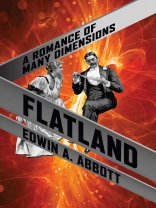“AT ONCE A PLAYFUL BRAINTEASER ABOUT GEOMETRY, A POINTED SATIRE OF VICTORIAN MANNERS—AND A STRANGELY COMPELLING ARGUMENT ABOUT THE GREATEST MYSTERIES OF THE UNIVERSE.” – The Wall Street Journal
This highly entertaining satirical novella, written by English schoolmaster Edwin A. Abbott was first published in 1884, and for more than 100 years has continued to charm readers.
A masterpiece of science fiction, it is in actuality a social commentary told through a mathematical framework offering pointed observations on the social hierarchy of Victorian culture. Abbott recounts the journeys of A. Square, a mathematician and resident of the two-dimensional Flatland, where women, represented by thin, straight lines are the lowliest of shapes, and where men may have any number of sides, depending on their social status.
Through unusual occurrences, A. Square, has his perspective transformed forever as he comes into contact with a host of geometric forms, including those of one dimension in Lineland, three dimensions in Spaceland, and no dimensions in Pointland. He is returned to his two-dimensional world after he entertains a revolutionary idea of visiting a land of four dimensions.
Flatland is not only fascinating book, but it is also a first-rate fictional introduction to the concept of the multiple dimensions of space. Einstein’s 1915 publication of the theory of relativity made
Flatland popular as a prophet of four dimensions. It is still popular today amongst mathematics, physics, and computer science students. This brilliantly eccentric classic is an invitation to see beyond our own reality and influenced writers from Carl Sagan to Stephen Hawking.
عن المؤلف
Edwin Abbott Abbott, English schoolmaster and theologian, is best known as the author of the mathematical satire Flatland (1884).
He was educated at the City of London School and at St John’s College, Cambridge, where he took the highest honours in classics, mathematics and theology, and became fellow of his college. In 1862 he took orders. After holding masterships at King Edward’s School, Birmingham, and at Clifton College, he succeeded G. F. Mortimer as headmaster of the City of London School in 1865 at the early age of twenty-six. He was Hulsean lecturer in 1876.












